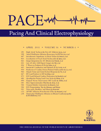Noncavotricuspid Isthmus-Dependent Right Atrial Tachycardia after Paroxysmal Atrial Fibrillation Ablation
Dr. Ju and Dr. Yang contributed equally to this work.
Relationship with Industry Policy: None
Abstract
Background: Atrial tachycardia (AT) is commonly encountered after atrial fibrillation (AF) ablation. But no study exclusively on noncavotricuspid isthmus-dependent right AT (NCTI-RAT) post-AF ablation has been reported. The present study aims to describe its prevalence, electrophysiological mechanisms, and ablation strategy and to further discuss its relationship with AF.
Methods: From July 2006 to November 2009, 350 consecutive patients underwent catheter ablation for paroxysmal AF. A total of seven patients (2.0%) developed NCTI-RAT after left atrium ablation for AF. In these highly selected patients (two male, mean age 54 ± 11 years, mean left atrium diameter of 34 ± 7 cm), all had circumferential pulmonary vein isolation in their initial procedures and three of them had additional complex fractionated electrograms ablation in the left atrium and the coronary sinus.
Results: Totally, nine NCTI-RATs were mapped and successfully ablated in the right atrium with a mean cycle length of 273 ± 64 ms in seven patients. Five ATs in three patients were electrophysiologically proved to be macroreentry and the remaining four were focal activation. All the ATs were successfully abolished by catheter ablation. After a mean follow-up of 29 ± 15 months post-AT ablation, all patients were free of AT and AF off antiarrhythmic drugs.
Conclusions: NCTI-RAT is relatively less common post-AF ablation. Totally, 2.0% of paroxysmal AF patients were revealed to have NCTI-RAT. (PACE 2011; 34:391–397)




